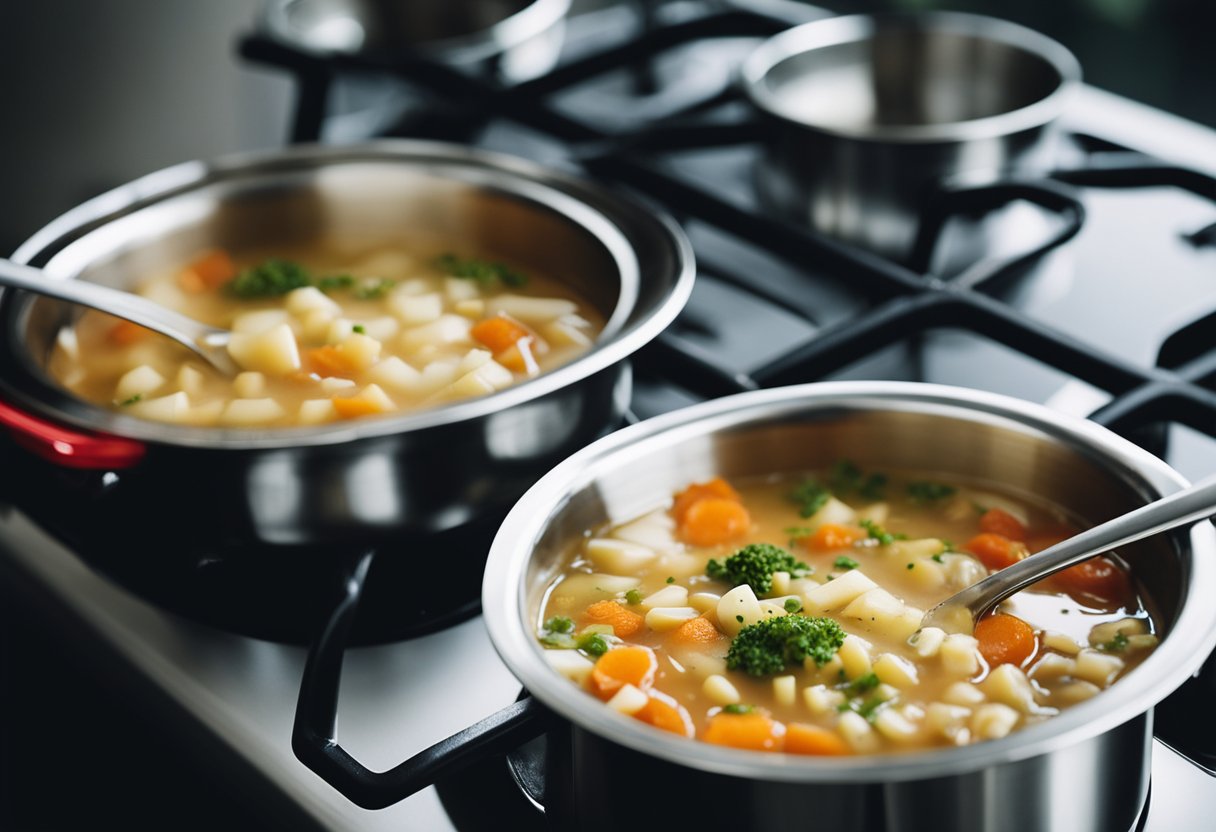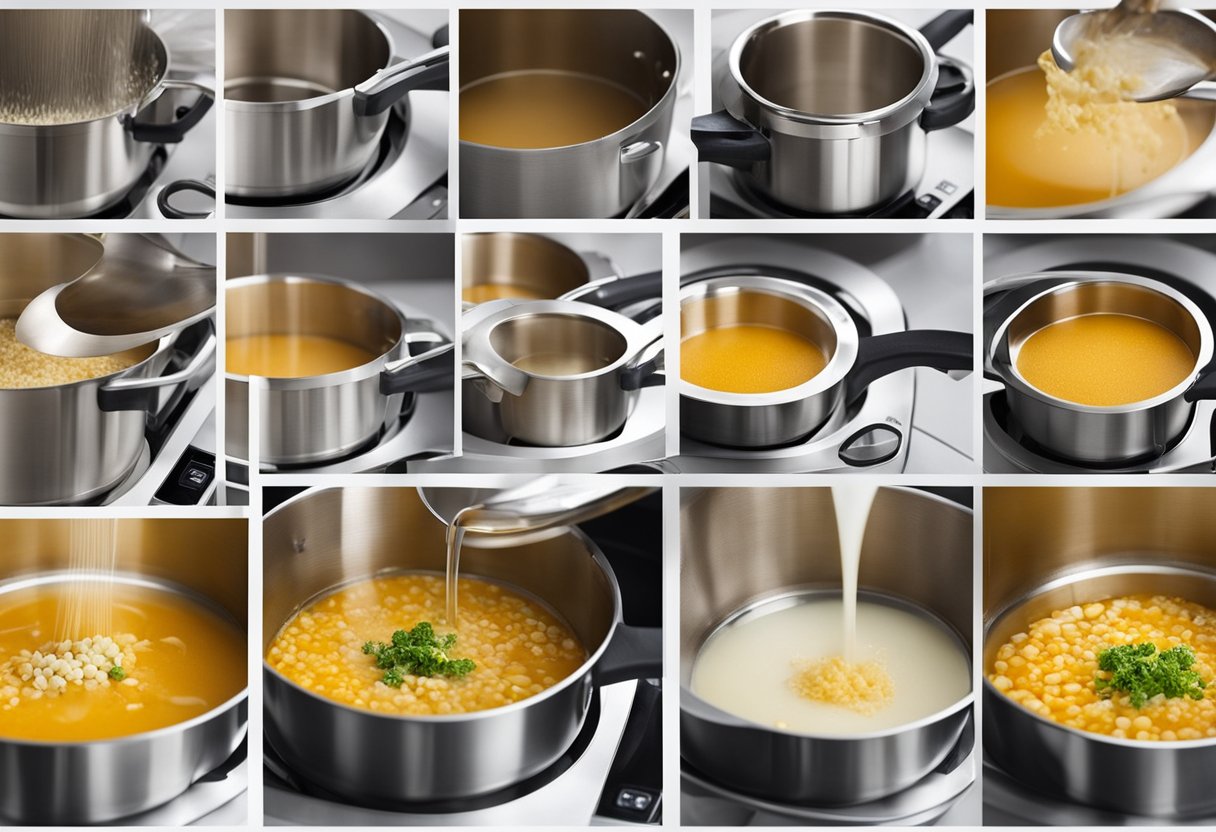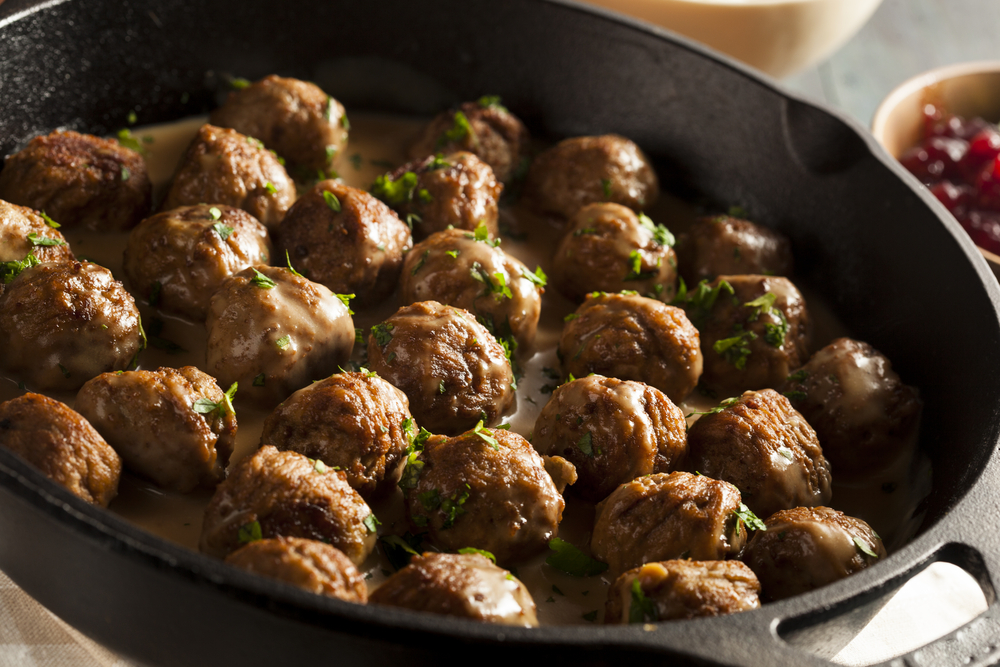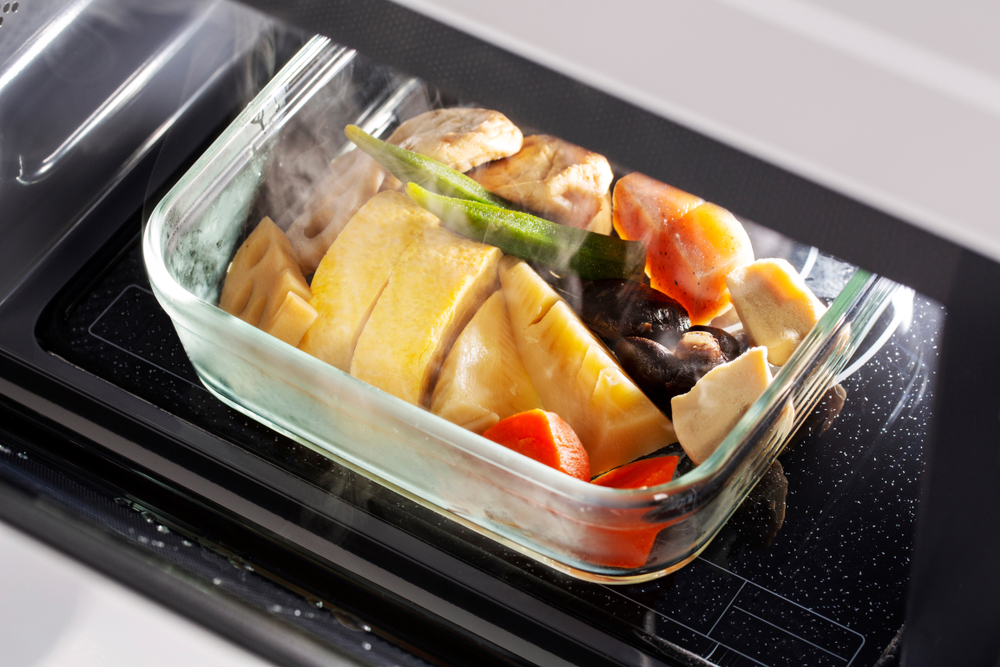Reheating soup is a common practice for many households. Whether you are trying to use up leftovers or simply craving a comforting bowl of soup, knowing how to reheat soup properly is essential to maintain its quality and safety.
In this article, I will share some tips and tricks on how to reheat soup, including the best methods for different types of soup and how to store and freeze soup for later use.

Understanding the basics of soup reheating is important to ensure that your soup is heated evenly and at the right temperature.
Depending on the type of soup, reheating time and method may vary. Some soups may require slow and gentle heating, while others can be reheated quickly in the microwave.
In addition, it is crucial to ensure that your soup is heated to at least 165°F (74°C) to kill any harmful bacteria that may have grown during storage.
Key Takeaways
- Reheating soup is a common practice for many households, but it is important to do it properly to maintain its quality and safety.
- Understanding the basics of soup reheating, including the right temperature and heating time, is crucial to ensure that your soup is heated evenly and safely.
- The best methods for reheating different types of soup may vary, and it is important to follow specific instructions to maintain the soup’s flavor and texture.
Understanding the Basics of Soup Reheating
As someone who loves soup, I know that reheating it can be a bit tricky. You want it to be hot and flavorful, but you also want to make sure it’s safe to eat.
Here are some basics to keep in mind when reheating soup:
- Reheating Methods: There are a few different ways to reheat soup, including on the stove, in the microwave, and in the oven. Each method has its pros and cons, so it’s important to choose the one that works best for you and your soup.
- Soup Temperature: Before you start reheating your soup, make sure it’s at room temperature. If it’s too cold, it will take longer to heat up and may not heat evenly. If it’s too hot, you could burn yourself when handling it.
- Soup Storage: When storing soup, make sure it’s in an airtight container in the refrigerator or freezer. This will help prevent bacteria growth and keep your soup fresh.
- Safety First: When reheating soup, it’s important to make sure it’s heated to a safe temperature of at least 165°F (74°C). Use a food thermometer to check the temperature and stir the soup frequently to ensure even heating.
- Flavor Preservation: To preserve the flavor of your soup, add a bit of water or broth when reheating. This will help prevent it from becoming too thick or salty.
By following these basics, you can reheat your soup safely and enjoyably.
Methods for Reheating Soup
When it comes to reheating soup, there are several methods to choose from. Each method has its own advantages and disadvantages, so it’s important to choose the one that works best for your situation.
Here are the most common methods for reheating soup:
Microwave
The microwave is the quickest and easiest way to reheat soup. To reheat soup in the microwave, transfer it to a microwave-safe bowl and cover with a microwave-safe lid or plate.
Heat on medium power for 2 minutes, then stir the soup and continue to heat in 30-second intervals until it is thoroughly warmed. Be sure to stir the soup between each interval to ensure even heating.
Stove
Reheating soup on the stove may take a little longer than the microwave, but it can be a good option if you want to avoid using the microwave.
No products found.
To reheat soup on the stove, transfer it to a pot and heat over medium heat, stirring occasionally until it is thoroughly warmed. This method may take anywhere from 5 to 15 minutes depending on the amount of soup you are reheating.
Instant Pot
If you have an Instant Pot, you can use it to reheat soup quickly and easily. To reheat soup in an Instant Pot, add the soup to the pot and select the “Soup” function.
Set the time for 5 minutes and let the Instant Pot do the rest. Once the soup is heated, release the pressure manually and serve.
- 7-IN-1 FUNCTIONALITY: Pressure cook, slow cook, rice cooker, yogurt maker, steamer, sauté pan and food warmer.
- QUICK ONE-TOUCH COOKING: 13 customizable Smart Programs for pressure cooking ribs, soups, beans, rice, poultry, yogurt, desserts and more.
- COOK FAST OR SLOW: Pressure cook delicious one-pot meals up to 70% faster than traditional cooking methods or slow cook your favorite traditional recipes – just like grandma used to make.
- QUICK AND EASY CLEAN UP: Finger-print resistant, stainless-steel sides and dishwasher-safe lid, inner pot, and accessories.
- SAFETY FEATURES: Includes over 10 safety features, plus overheat protection and safe-locking lid
Slow Cooker
Reheating soup in a slow cooker is a great option if you want to keep the soup warm for an extended period of time. To reheat soup in a slow cooker, add the soup to the pot and set the temperature to “Low” or “Warm.” Stir occasionally to ensure even heating.
This method may take anywhere from 1 to 4 hours depending on the amount of soup you are reheating.
Overall, the method you choose for reheating soup will depend on your personal preferences and the amount of time you have available. If you need to reheat soup quickly, the microwave or Instant Pot may be your best options.
If you have a little more time, the stove or slow cooker may be a better choice. Regardless of which method you choose, be sure to follow proper food safety guidelines and heat the soup to the appropriate temperature to ensure that it is safe to eat.
How to Reheat Different Types of Soup
When it comes to reheating soup, different types of soup require different methods to ensure that they taste as good as they did when they were first made.
In this section, I will walk you through the different ways to reheat four common types of soup: cream-based soups, vegetable soups, seafood soups, and broth-based soups.
Cream-Based Soups
Cream-based soups are notoriously tricky to reheat because the cream can separate and curdle if it gets too hot.
To reheat a cream-based soup, follow these steps:
- Pour the soup into a saucepan and heat it over low heat. Be sure to stir the soup constantly to prevent it from sticking to the bottom of the pan.
- Once the soup is hot, remove it from the heat and stir in a splash of milk or cream. This will help to smooth out the texture of the soup and prevent it from curdling.
- If the soup is still too thick, you can add a little bit of chicken or vegetable broth to thin it out.
Vegetable Soups
Vegetable soups are relatively easy to reheat, but you need to be careful not to overcook the vegetables.
To reheat a vegetable soup, follow these steps:
- Pour the soup into a saucepan and heat it over medium-low heat.
- Once the soup is hot, reduce the heat to low and simmer it for a few minutes to ensure that the vegetables are heated through.
- If the soup is too thick, you can add a little bit of chicken or vegetable broth to thin it out.
Seafood Soups
Seafood soups are delicate and can easily become overcooked if reheated improperly. To reheat a seafood soup, follow these steps:
- Pour the soup into a saucepan and heat it over low heat.
- Once the soup is hot, remove it from the heat and stir in any cooked seafood that you want to add. Be sure to stir gently to avoid breaking up the seafood.
- If the soup is too thick, you can add a little bit of chicken or seafood broth to thin it out.
Broth-Based Soups
Broth-based soups are the easiest type of soup to reheat. To reheat a broth-based soup, follow these steps:
- Pour the soup into a saucepan and heat it over medium-low heat.
- Once the soup is hot, reduce the heat to low and simmer it for a few minutes to ensure that all of the ingredients are heated through.
- If the soup is too thin, you can add some cooked noodles, grains, or rice to thicken it up.
By following these simple steps, you can ensure that your reheated soup tastes just as good as it did when it was first made.
Storing and Freezing Soup
When it comes to storing and freezing soup, there are a few things to keep in mind to ensure that your soup stays fresh and delicious for as long as possible.
Here are some tips for refrigerating, freezing, and thawing soup:
Refrigeration
If you plan to eat your soup within the next few days, storing it in the refrigerator is the best option. Be sure to let your soup cool completely before transferring it to an airtight container.
Glass or plastic containers with tight-fitting lids work well, as do freezer-safe Tupperware or Souper Cubes.
A general rule of thumb is that soup can be stored in the refrigerator for about three days, but you should always taste your dish before deciding to reheat.
A clear, vegetable-based soup with some acidity, such as tomatoes, may last longer. Chicken soup usually lasts three to five days.
Freezing
If you want to freeze soup, it’s important to use freezer-safe containers. Avoid using glass containers that are not labeled as freezer-safe, as they may crack or shatter when exposed to extreme temperatures. Plastic containers or freezer bags work well.
When freezing soup, it’s best to freeze individual portions rather than one large batch. This makes it easier to thaw and reheat only what you need.
Souper Cubes or other freezer containers with individual compartments are a great option for this.
Thawing
When it’s time to thaw your soup, there are a few methods you can use. The easiest way is to transfer your frozen soup from the freezer to the refrigerator and let it thaw overnight. This method ensures that your soup thaws evenly and safely.
If you’re in a hurry, you can also thaw your soup in the microwave. Be sure to transfer your soup to a microwave-safe container and heat it on the defrost setting. Stir the soup frequently to ensure that it thaws evenly.
Avoid thawing your soup on the countertop, as this can lead to bacteria growth and spoilage.
Overall, by following these tips for storing and freezing soup, you can enjoy your favorite soups anytime you want without worrying about freezer burn or spoilage.
Tips for Maintaining Soup Quality
As someone who loves making soup, I know that reheating it can be a bit of a challenge. However, with a few tips and tricks, you can maintain the quality of your soup and enjoy it just as much the second time around.
Storing Leftovers
When storing leftover soup, it’s important to let it cool down to room temperature before placing it in the refrigerator or freezer.
This will prevent bacterial growth and ensure that your soup stays fresh for longer. If you’re short on time, you can speed up the cooling process by placing the pot of soup in a water bath.
Reheating Creamy Soups
Cream-based soups can be a bit tricky to reheat. If you’re not careful, they can turn mushy or separate.
To prevent this, try adding a bit of flour or puree to thicken the soup and keep it creamy. You can also try reheating the soup in a double boiler or using a pressure cooker or Instant Pot.
Avoiding Lumps
If your soup has lumps or is too thick, you can try using a roux to thicken it up. Simply melt some butter in a pan, add flour, and whisk until smooth.
Then, gradually add the roux to your soup, stirring constantly until it reaches the desired consistency.
Adding Toppings
To give your reheated soup a bit of extra flavor and texture, consider adding some toppings. Chopped herbs, croutons, or a dollop of sour cream can all be great additions to a bowl of soup.
Meal Prepping
If you’re meal prepping, it’s important to undercook your soup slightly so that it doesn’t become mushy when reheated. You can also freeze soup in individual portions to make it easier to reheat later on.
By following these tips, you can maintain the quality of your soup and enjoy it just as much the second time around. Don’t let food waste get in the way of enjoying your favorite soups and stews!
Frequently Asked Questions

How long to reheat soup in microwave?
When reheating soup in the microwave, it’s important to do it slowly and evenly to avoid burning or overcooking.
I recommend heating soup for 2 minutes on medium power, stirring, and then continuing to heat in 30-second intervals until it’s thoroughly warmed. This method can take anywhere from 2-5 minutes depending on the quantity and type of soup.
- 【Pre-programmed sensor menu】 for optimum heating of popular foods like pizza, potatoes, veggies and more; Power Wattage (Microwave): 1100W; Rated Voltage: 120V – 60Hz
- 【Stylish Appearance with Large Interior, fitting a 12inch Pizza】Black exterior, 20.51 x 17.14 x 12.83 inch (w x d x h); large 1. 2 cubic feet capacity, cavity 13.07 x 15 x 9.5 inch (w x d x h), removable turntable 12.4 inch (diameter)
- 【Other Functions】1100 watts with 10 power settings, defrost by time&weight, clock, and kitchen timer, One touch start for multiple food presets
- 【Practical Control Panel】Large digital display, easy-to-read control panel. The keypad was covered by a protective film during the shipment. Please peel it off before your first use.
- 【Mute Function】If you wish to mute the buzzer of the microwave, pleas long press on the button “8” for 3-5 seconds. The buzzer is automatically switched off after a long beep.
Best container to store soup in fridge?
The best container to store soup in the fridge is an airtight container that is microwave-safe. Glass containers with tight-fitting lids or plastic containers specifically designed for food storage are good options.
Avoid using metal containers as they can react with the soup and alter the taste.
Can I reheat soup twice?
It’s generally safe to reheat soup twice, but it’s important to do so within 24-48 hours of the initial cooking. When reheating soup, make sure it reaches a temperature of at least 165°F to kill any bacteria that may have grown.
Reheating soup temperature?
When reheating soup, it’s important to do so to a temperature of at least 165°F to kill any bacteria that may have grown. Use a food thermometer to check the temperature of the soup before serving.
How long does homemade soup last in the fridge?
Homemade soup can last in the fridge for up to 3-4 days if stored properly in an airtight container. If you’re unsure if the soup is still good, give it a sniff and taste before reheating.
Is it better to heat up soup on the stove or microwave?
Both methods are effective for reheating soup, but using the stove allows for more control over the heating process.
No products found.
When reheating on the stove, use a low to medium heat and stir frequently to avoid burning. However, the microwave is a quicker option and is convenient for heating up a single serving of soup.









